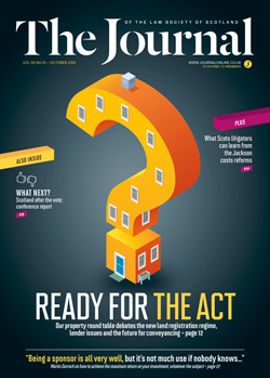The test for causing alarm

Section 38(1) rides again
After setbacks with the perennial charge of breach of the peace suffered by the Crown in Harris v HM Advocate [2009] HCJAC 80 and [2010] HCJAC 102, the offence of behaving in a threatening or abusive manner was created by s 38(1) of the Criminal Justice and Licensing (Scotland) Act 2010. It quickly became the default choice of charge by the procurator fiscal when prosecuting all manner of allegedly disorderly conduct, breach of the peace being reserved for more special occasions.
The practice continued until the inappropriately named case of Jolly v HM Advocate 2013 SCCR 511. This singular case was thought to suggest that where the intended recipient of the abuse was either not aware of it or had not been present, no s 38(1) offence was created. That position was in contrast to the decision in Rooney v Brown 2013 SCCR 334, where the accused had been convicted of a series of vile, general and specific threats to well-known persons both dead and alive, while being conveyed in a police van after having been arrested on other matters.
A five-judge bench was convened to consider these apparently conflicting decisions, and a number of cases were gathered together to assist consideration of the points raised in Paterson v PF Airdrie; Bow v PF Airdrie; Love v PF Stirling [2014] HCJAC 87 (14 August 2014).
Paterson was on all fours with Rooney in that the appellant had shouted and sworn at police officers both before his arrest and when in a police vehicle. The police officers had not suffered fear and alarm from the accused’s threatening and abusive behaviour. The sheriff distinguished Jolly as the appellant’s conduct had occurred in public, in a residential area with a known problem for youth disorder, and the behaviour was sufficient to be likely to cause a reasonable person to suffer fear and alarm.
In Bow the complainer, who was of Indian origin, was driving to collect his daughter from school when the road was blocked by a bin lorry. As the complainer tried to get past, the appellant remonstrated with him, threatened him with violence, swore and directed racial abuse at him. When the complainer sought to take a photograph of the lorry he was subjected to further abuse. On the complainer’s return journey the appellant took the opportunity to draw up next to his car and subject him to more abuse.
There was no evidence that the complainer suffered fear or alarm; presumably he regarded the appellant’s tirades as ignorant abuse. The sheriff convicted on the basis that the appellant’s behaviour would be likely to cause a reasonable person to suffer fear or alarm. The racial aggravation could be established on the basis of the complainer’s evidence, but the appellant’s police interview suggested he was not a stranger to using terms of racial abuse.
Love’s case involved posting sectarian football-related abuse on the public section of his Facebook page, which resulted in a complaint to the police by a woman who had accessed the site. Once again the sheriff concluded that a reasonable person was likely to suffer fear and alarm reading the comments, or that the appellant was at least reckless posting them. The comments were religiously aggravated and were motivated by malice and ill will towards Roman Catholics.
The appeal court upheld all three convictions, concluding that Jolly had been wrongly decided and that the formulation in Rooney was an accurate reflection of the objective test set out in s 38(1)(b), namely whether the behaviour would be likely to cause a reasonable person to suffer fear or alarm.
By way of a postscript, the Lord Justice General thought Jolly had not been wrongly decided on its facts, but that in the circumstances of that case the defence contained in s 38(2) could have been deployed successfully. Jolly, in a confidential interview with social workers with a view to his parole being considered, had indicated that if released he would kill the complainer in the original case. She was, of course, not present. The social workers, who were not personally alarmed, very properly passed the information on to police, who reported the matter for prosecution when the priority should have been to ensure that the complainer received an Osman-type letter (Osman v UK (1998) 29 EHRR 245), that there had been threats made against her, and details of the interview reported to the Parole Board in order that they could consider the question of public safety should the appellant be released.
Contempt of court – prevarication
Perjury and prevarication are endemic in the courts, but there is rarely the opportunity for the authorities to take action. Two recent cases involving prevarication show that a robust line will be taken against witnesses who feign lack of memory and cause proceedings to collapse due to the lack of corroborative evidence.
In Bowie, Petitioner [2014] HCJAC 65 (6 June 2014), an appeal was heard against a finding of contempt of court and sentence of 12 months’ imprisonment. An accused had been indicted on charges of assaulting the petitioner and her friend at a party, behaving in a threatening and abusive manner, and maliciously breaking windows, all with a knife. The other complainer, the accused’s ex-partner, had given evidence supporting the libel. The petitioner initially had denied the accused had been at the party. A signed police statement was put to her and she vacillated in her evidence about whether she had given it. The details contained in the statement would have provided evidence to support the charges but the petitioner denied its terms. During a break in the proceedings it was suggested the petitioner had spoken to the accused on her phone. She initially denied this, but subsequently admitted it.
The prosecutor withdrew the charges against the accused due to insufficient evidence. The sheriff questioned the petitioner, then remanded her to later in the day for her to obtain legal advice. He then found her in contempt of court, and after remanding her for reports, sentenced her to 12 months’ imprisonment.
It was accepted at the appeal that the sheriff had not followed the guidelines set down in Robertson v HM Advocate 2008 JC 146; 2008 SCCR 20. The court also distinguished Childs v McLeod 1981 SLT (Notes) 27 and the criticism that the statement put to the petitioner had not been proved during the proceedings. In the present case, the statement had been signed by the petitioner, and at one stage in her evidence she accepted both giving and signing it.
The appeal court also said the sheriff was best placed to assess the circumstances and prevalence of prevarication, and that although the petitioner had no previous convictions and came from a stable and supportive family background, having regard to the serious nature of the conduct, the sentence could not be regarded as excessive.
On 18 June 2014, a different bench of the appeal court heard the case of Hood, Petitioner [2014] HCJAC 85. The petitioner had given evidence at the trial of a man accused of assaulting him and one Fraser.
The petitioner alleged that he had been unable to recall the circumstances of the events as he had been concussed by the injury he sustained and had been taking drugs and alcohol.
The sheriff based his finding of contempt on the petitioner’s demeanour and the similarity of his evidence to that of Fraser. The petitioner had given a statement about the incident to the police at the time, and the event “must have been a significant one in his life given the nature of his injury”. His account was “ludicrous” and not credible.
The appeal court was satisfied the sheriff used his authority as confirmed in McLeod v Spiers (1884) 5 Couper 387 and followed the procedure set out in Robertson. The sheriff was best placed to make the finding. The petitioner was sentenced to four months’ imprisonment to run consecutively to a sentence he was presently serving.
Robertson, at paras 83-100, sets out the procedure to be followed when prevarication is suspected, and those guidelines are supplemented by the Act of Adjournal, Chapter 29B.
Beware of signed precognitions
Had I been aware of the decision in Beurskens v HM Advocate [2014] HCJAC 99 (26 February 2013) many years ago, it would have made my job as a procurator fiscal a lot more straightforward.
Lord Marnoch alluded in his dissenting opinion to the stern words of Lord Justice Clerk Thomson in Kerr v HM Advocate 1958 JC 14 at 19, on which I was brought up, that a precognition is a document which has been “filtered through the mind of another”. Precognoscers “as a whole appear to be gifted with a measure of optimism which no amount of disillusionment appears to dampen”.
It has now been decided, due to developments in the law of disclosure and the use of statements at trial generally, that documents compiled during the course of the investigative part of the inquiry which were in the nature of precognitions but had been signed by the witness, would be classed as statements and could be used inter alia as the basis of an application under s 259 of the Criminal Procedure (Scotland) Act 1995 to admit the evidence contained therein due to the death in the interim of the witness.
In this issue
- Respect revived
- Adoption: when should contact continue?
- Family values
- Designs on IP law
- Section 29 claims, time bar and service
- Sharing the rewards
- Reading for pleasure
- Opinion: Lauren Wood
- Book reviews
- Profile
- President's column
- Making the big changeover
- People on the move
- Another leap forward
- LBTT: aligning payment and registration
- The (legal) people have spoken
- Powers of attorney: another angle
- Greatness begins with a pin badge
- Jackson: has it delivered?
- The test for causing alarm
- When do licensed premises "cease to be used"?
- Empowering communities
- Has clawback lost its tax bite?
- Scottish Solicitors Discipline Tribunal
- Property Law Committee Update
- Call it a comeback
- Refereeing the referendum
- Law reform roundup
- From the Brussels office
- What's next for SYLA?
- Mediation first
- When life begins at 60
- With growth there is risk? (2)
- Ask Ash
- Sustainable future: new ideas for the training contract
- Mentoring - why?
- Lender Exchange: what's it about?
- A bar removed






